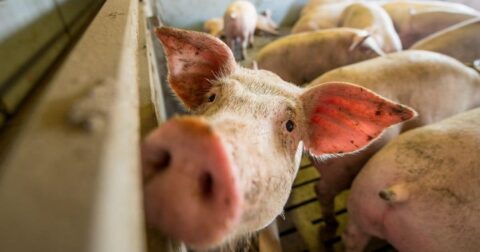Analysis
The Loss of Chevron Could Also Be a Major Loss for Animals
Law & Policy•6 min read
Explainer
Why are so many animals left out of the Animal Welfare Act? We explain the history of the law, and its shortcomings.


Words by Claire Hamlett
Originally passed in 1966, the Animal Welfare Act, or AWA, is the primary federal law that protects nonhuman animals in the United States. Though its regulations are limited, the law provides at least some minimum standards for the way animals are treated. But the law has a pretty specific definition of who counts as an animal worth protecting. Warm-blooded animals used in research, experimentation, exhibition purposes or as a pet are considered animals under the law — but birds, rats and mice are not. Farm animals, whether mammals or poultry, don’t count as protected animals under the AWA, either.
Regardless of its many shortcomings, the law is still an important one to understand. Let’s take a look at how the Animal Welfare Act came to be, what it actually says and how it continues to evolve as a piece of legislation.
In the 1950s in the U.S., an underground economy operated in which stolen pets were often sold to animal researchers for medical experiments. The poster child for the first animal welfare law was Pepper the Dalmatian. Pepper’s 1965 dognapping led her owners to drive throughout Pennsylvania searching for her, garnering the support of animal advocates, the police and, ultimately, Capitol Hill lawmakers. Pepper’s family found out about her death after she was cremated following a failed experiment at a New York hospital’s facility for research into cardiac pacemakers.
After Pepper’s story came out in Sports Illustrated, animal advocates worked with Life magazine to show the terrible conditions in which dogs were kept prior to being sold to medical research facilities. The feature provoked a national outcry over the treatment of animals as test subjects. Just over a decade later, the Animal Welfare Act was signed into law.
Animal welfare has three main elements:
The AWA covers warm-blooded animals used in research, exhibitions, breeding for sale, and in transport, though there are many exceptions: rats, mice and birds bred for use in research, horses not used in research, farmed animals, amphibians, reptiles, fish and invertebrates. While the AWA technically covers birds, birds are not actually protected under the law. “Free-living wild animals” in their natural habitat are also covered by the Act to some extent, according to an Association of Fish and Wildlife Agencies webinar.
The way that the term “animal” is defined excludes most animals who are used for laboratory research, including birds, rats and mice. It also excludes farmed animals or animals used in agriculture, invertebrates, reptiles and amphibians.
Other animals that are explicitly exempt from protection under the Act are animals used in “activities related to food, fur or fiber,” horse races, dog races and field trials, according to a USDA webinar. Animals on hunting or game preserves, or on certain sanctuaries are also excluded. The Act also does not regulate the care of pets and companion animals by their owners or by retail pet stores.
The inaugural 1966 law aimed to prevent pet dogs and cats from being stolen and sold for laboratory experiments. It also set up standards to protect dogs, cats and other animals owned by animal dealers and research facilities. These other animals included hamsters, guinea pigs, rabbits and nonhuman primates.
Starting in 1967, animal dealers were required to get a license, and research facilities that intended to use cats or dogs in research, tests and experiments had to register with the USDA. The Act allowed the USDA to conduct unannounced inspections of facilities, and to require that dealers and research facilities maintain specific records. Records of the identities of cats and dogs were prioritized over other animals like monkeys and rabbits.
Animal dealers were defined as people who transport, buy, or sell dogs or cats for research purposes, and the Act had limitations, applying primarily to dealers and government-funded research facilities that were doing business across state lines, for example.
Several amendments were made to the 1966 law in 1970, including a name change: it would now be known as the Animal Welfare Act instead of the Laboratory Animal Welfare Act. The definition of “animal” was broadened to include all warm-blooded animals used in research or for exhibition, or sold as pets. Yet farm animals and horses not used for research were excluded. In the following decades, there were several attempts by state representatives to get farmed animals included in the AWA. Despite support from animal welfare groups, these failed to get enough political support to become law.
The 1970 amendments also gave the USDA new but very limited authority to regulate the use of pain-relieving medications during experiments on animals in research facilities. The definition of a research facility was also expanded to include facilities that were using live animals as defined by the Act, not just cats and dogs.
The 1976 Animal Welfare Act amendments included a change to make animal fighting illegal and also exempt hunting animals from the law. The amendments broadened the Act to regulate all commercial transportation of animals, requiring carriers and intermediate handlers to now register with the USDA. This change meant the AWA now covered livestock — but only when animals are being transported.
1985
The AWA was again amended in 1985 to establish committees to make research facilities more accountable to communities with an interest in animal welfare. In addition, researchers would have to consider alternative procedures to minimize pain and distress in live animals who were subjects of their experiments. Passed as part of the Farm Bill, the amendments also established an Animal Welfare Information Center at the National Agricultural Library.
In 1990, amendments to the AWA were passed to require pounds and shelters to hold cats and dogs for at least five days before they could be sold to dealers. Dealers would also now have to keep a written record that included where their cats and dogs had been bred and raised.
Amendments to the AWA in 1990 were passed as a section titled “Protection of Pets,” also known as the Pet Theft Act, within the omnibus Farm Bill passed that year.
Rats, birds and mice bred for research were excluded from the definition of animal in the 2002 amendments to the AWA, which formed part of the Farm Bill passed that year — the Farm Security and Rural Investment Act of 2002. The ongoing impact of these amendments is that 95 percent of the animals used in research are no longer protected under the Act.
The Animal Fighting Prohibition Act, introduced in 2007, outlawed purchasing, selling or possessing knives that are attached to the legs of birds used in cockfighting.
The 2008 amendments increased the maximum penalty for each violation from $2,500 per animal per day to $10,000. Penalties and prohibitions related to animal fighting were also increased.
In 2013, amendments to the Act excluded owners of common pets who live under the same roof as their exhibited animals from the definition of exhibitors, as long as the exhibitor did not make a substantial portion of their income from animal exhibitions.
As of 2019, the AWA prohibits animal fighting in U.S. territories such as Guam, Puerto Rico and the U.S. Virgin Islands, where animal fighting was previously permitted by local laws.
Birds not used in research are now included in the AWA, meaning people or businesses who are transporting, breeding, exhibiting or dealing birds may need a license. Chickens and other poultry remain unprotected.
What Does The Animal Welfare Act Actually Do?
Investigations
One purpose of the Animal Welfare Act is to empower the USDA Office of Inspector General to conduct investigations into violations of the AWA. They often work with other law enforcement agencies, including the FBI to break up dog-fighting rings and or arrest illegal traffickers of exotic animals.
Inspections
The Act also regulates inspections. USDA Animal Care inspectors carry out routine, unannounced inspections of all businesses and facilities that are licensed or registered under the AWA. Inspections occur at research facilities using regulated animals at least once a year.
Is The Animal Welfare Act Effective?
The list of animals who are not protected by federal law is significantly longer than the list of animals who are protected. Species that are regulated by the Act are limited to those used in research, shown to the public, bred for sale as pets or transported. Even within the realm of animal-based biomedical research, for example, there are no protections for the care of animals in their post-laboratory lives.
Many animal advocacy groups have criticized the law and its enforcement. The ASPCA has accused the USDA of failing to properly regulate puppy mills. The organization also views the AWA as too weak — and its enforcement too lax. World Animal Protection has given the United States an overall “D” grade in its Animal Protection Index, pointing to its narrow scope and sometimes ineffective enforcement.
The Bottom Line
For a more detailed legislative history of the AWA, and efforts to expand the animals protected under the law, read the summaries from the Animal Welfare Institute and the Animal Legal and Historical Center at Michigan State University. If you suspect a person or group of cruelty to animals in violation of the AWA, alert the authorities.
Some research for this post was contributed by Hemi Kim